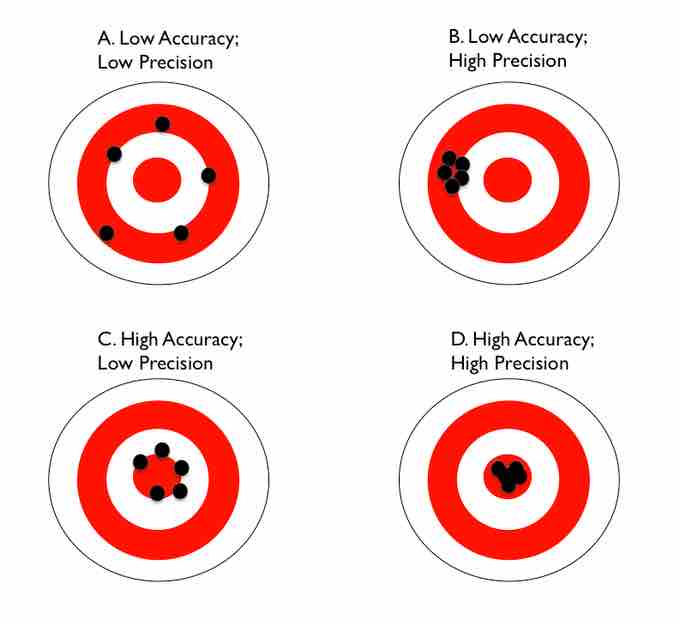Understanding Accuracy vs. Precision
When scientists conduct research, they strive to collect data that is both accurate and precise. If their data is both accurate and precise, this gives them confidence that it is valid.
Accuracy
"Accuracy" is the closeness of a measurement quantity to that quantity's true value. In other words, it is the extent to which the measurement is error free. For example, if Dr. Smith is collecting data on people's height and she measures someone who is rather short—63 inches (5'2" and a half)—at exactly 63.0 inches, she is accurate. However, if Dr. Smith collects a measurement for that person that is 67.5 inches, her measurement is now inaccurate because it is no longer close to the true value.
Precision
"Precision" is the degree to which two or more repeated measurements show the same results each time. Sometimes precision is referred to as the reliability or consistency of the measurement.
Let's return to our example above: Dr. Smith, who is collecting data on height. Often researchers will take repeated measurements of the same entity for a variety of reasons related to data quality. Dr. Smith is collecting data on each person's height three times for her study. If she measures that same 63-inch tall person three times, and collects measurements of 67.5, 67.4, and 67.4, this means that she has collected very precise measurements. Note that her measurements are not accurate, however: they are far from this person's actual height of 63 inches. In this way, measurements can be quite precise, but not accurate. Thankfully Dr. Smith's grad student also measures the same 63-inch tall person and obtains measurements of 63.0, 63.01, and 63.0. The grad student's measurements are not only precise, but accurate as well because they are consistent and also very close to the true height.
Note that measurements can also be accurate, but not precise. In the above example, if Dr. Smith obtained measurements of 63, 64, and 62.5, these would be accurate because they are close to the person's true height, but not precise, because they lack consistency.

Accuracy vs. precision
Accurate hits fall close to the bullseye, as shown in dart boards C and D. Precise hits are characterized by the close clustering of consistent hits, shown in dart boards B and D.
Let's look at another example. If a basketball player is taking shots, she is accurate if her aim always takes the ball close to, or into, the basket. If her aim takes the ball to the same location each time, whether or not it's close to the basket, she is precise. A great basketball player is accurate and precise by shooting the ball exactly the same way each time and getting it into the basket.
Measurement Error
When researchers collect data, they strive for both accuracy and precision so that their data are valid and they can reduce variance in their results due to error. Measurement error can occur for a variety of reasons. Suppose you are measuring the weight of various objects in your physics class, but your scale is off by .5 oz. This small difference introduces systematic error into your measurements. The errors would be "systematic" because the same amount of error would be introduced each time you weighed something. However, if you and your lab mate simply overestimate or underestimate the weight each time because you are not paying attention, this would be an example of "random" error. The error is random because it will vary each time due to human error.